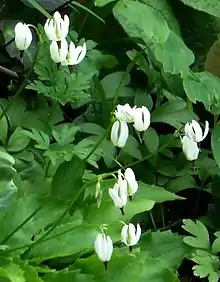Dodecatheon dentatum
Dodecatheon dentatum is a species of flowering plant in the family Primulaceae, known by the common names white shooting star and toothed American cowslip.
| Dodecatheon dentatum | |
|---|---|
 | |
| Scientific classification | |
| Kingdom: | |
| (unranked): | |
| (unranked): | |
| (unranked): | |
| Order: | |
| Family: | |
| Genus: | Dodecatheon |
| Species: | D. dentatum |
| Binomial name | |
| Dodecatheon dentatum | |
It is native to areas of western North America, in Arizona, British Columbia, Idaho, New Mexico, Oregon, Utah, Washington (state),[1] and Chihuahua in Mexico.[2]
Description
Dodecatheon dentatum is an herbaceous perennial growing to 40–50 cm (16–20 in) in height.
This species has toothed (dentate) leaves, hence one of its common names.[3] The leaves have pointed oval blades up to 10 cm long by 6 cm wide with wavy or toothed edges. Each is borne on a long, winged petiole.
The inflorescence contains 1 to 12 flowers. It arises on a tall, erect flowering stalk. The flower corolla has five white lobes each 1 or 2 centimeters long. They are reflexed away from the flower's center, which contains one style surrounded by large reddish, purplish or black anthers containing pollen.[4][5] Its bloom period is May to July.
It is the only shooting star to have populations with consistently white flowers.[3] In Utah, petals may be pink or pale violet; elsewhere petals are white or cream. Plants in Arizona and New Mexico have stamens with yellow filaments, in the Northwest filaments are dark maroon or black.[3]
Subspecies
This species is classified into several subspecies:[1][6]
- Dodecatheon dentatum subsp. dentatum — white shootingstar, native to the Pacific Northwest.[7]
- Dodecatheon dentatum subsp. ellisiae — Ellis' shootingstar, native to Arizona, New Mexico[8] and Chihuahua in Mexico. Also known as D. ellisiae.[2]
- Dodecatheon dentatum subsp. utahense — pink flowering shootingstar, endemic to Utah.[9] Also known as D. utahense.[10]
Cultivation
Dodecatheon dentatum is cultivated as a perennial ornamental plant, used in traditional and native plant shade gardens.[3] It is of special value to native bumble bees.[3] The plants usually go dormant almost immediately after flowering.[3]
This plant has gained the Royal Horticultural Society's Award of Garden Merit.[11][12]
References
- USDA.gov: Dodecatheon dentatum
- Flora of North America.org: Dodecatheon ellisiae 2009
- NPIN: Dodecatheon dentatum
- Dodecatheon dentatum. Washington Burke Museum.
- Dodecatheon dentatum. Flora of North America.
- The Nature Conservancy.org: Dodecatheon dentatum
- USDA Plants Profile for Dodecatheon dentatum subsp. dentatum
- USDA Plants Profile for Dodecatheon dentatum subsp. ellisiae (Ellis' shootingstar)
- USDA Plants Profile for Dodecatheon dentatum subsp. utahense
- Flora of North America.org: Dodecatheon utahense 2009
- "Dodecatheon dentatum". Royal Horticultural Society. Retrieved 24 July 2013.
- "AGM Plants - Ornamental" (PDF). Royal Horticultural Society. July 2017. p. 29. Retrieved 6 February 2018.
